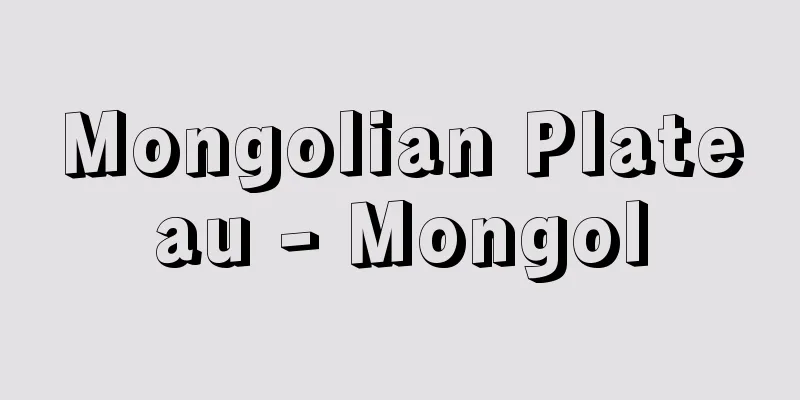Mongolian Plateau - Mongol

|
A plateau occupying the eastern part of Central Asia, where the Mongolian people mainly live. The area is also called Mongolia, and is centered on Mongolia and the Inner Mongolian Autonomous Region of China. It is limited to the Greater Khingan Mountains in the east, the Great Wall and the Qilian Mountains in the south, the Beishan Mountains and the Altai Mountains in the west, and the Sayan and Yablonoy Mountains in the north. It includes mountain ranges such as Hangai, Hentei, Yinshan, and Helan. Two-thirds of the area is over 1,500 meters above sea level. The northwest is higher, and the Mongolian Altai Mountains in particular have mountains that are around 4,000 meters above sea level. The center is the low-lying Gobi Zone (consisting of desert steppe and desert) with an altitude of 900 to 1,200 meters. The Gobi Zone divides the area west of the central part of the plateau into north and south, and continues to the Great Eastern Plain at an altitude of 700 meters to the east. Meanwhile, in the west it runs between the Khangai and Altai mountain ranges, reaching the Great Lakes Basin at an altitude of 750 to 1,600 meters, surrounded by these ranges and the Tannu-Ola mountain range. Rivers include the Arctic Ocean Selenga River, its tributary the Orkhon River, the Pacific Ocean Kerlen River, the Onon River, the Zavkhan River which flows into inland lakes, and the Khovd River, which flow into the northern half of the country, while the middle and upper reaches of the Yellow River flow through the southern part. In addition to inland lakes such as Lake Uvs and Lake Khara-Us in the Great Lakes Basin, there are many large lakes such as Lake Khuvsgul, Lake Dalai, and Lake Buyir, with the largest, Lake Uvs, covering an area of 3,350 square kilometers. The climate is poor in precipitation except for some parts of the north, and belongs to the steppe and desert climate zones. The annual precipitation in the mountainous areas, except for the Helan Mountains, the Beishan Mountains, and the Gobi-Altai Mountains, is 250-500 mm, in the plains it is less than 250 mm, and in the Gobi desert it is less than 100 mm. The climate is dominated by a continental climate, with significant annual and diurnal temperature ranges. The average temperature in January is -8 to -16 °C or less over the whole area, -16 to -24 °C or less north of the Gobi Desert, and -24 to -32 °C in the northern mountainous area. In July, the temperature is 16 to 24 °C over almost the whole area, 24 to 32 °C in the Alashan Desert in the south, and 8 to 16 °C in the northern mountainous area. The soil is gray forest soil in the northern mountainous area, and chernozem is mixed in the Greater Khingan Mountains. The plains other than the Altai, Hangai, Hentei, Yinshan, Helan, and Qilian mountain ranges and the Gobi are chestnut brown soil, the desert parts of the Gobi are gray-brown desert soil, and the desert steppe parts are semi-desert soil. As for vegetation, taiga (coniferous forest zone) is distributed mainly in the mountains on the northern border, forest steppe spreads in the Mongolian Altai, Hangai, Hentei, southern Greater Khingan Range, Yinshan, and Qilian mountain ranges, and the highest parts of the Mongolian Altai and Hangai mountain ranges are alpine zones. The inland areas are pure steppe, and most of the further inland areas north and east of the Gobi-Altai are desert steppe, and the south is desert. Animals that live mainly in the steppes include the Tarbagan, Mongolian gazelle, and Cossack fox, while in the Gobi region there are the Manchu gazelle, saiga antelope, wild camels, Asiatic wild asses, and Gobi brown bears, and in the mountainous areas of Altai and Khangai there are wild sheep, wild goats, and snow leopards. Since the Mongolian Plateau is dominated by steppes, it has been inhabited since ancient times by nomads who raised five livestock: sheep, goats, horses, cattle, and camels. These peoples include the Xiongnu, Xianbei, Rouran, Turks, Uighurs, Khitans, and Mongols, all of whom built powerful nomadic nations. After the Turkic Turks and Uighurs fell, Mongolian tribes gradually gained control of the land, and the establishment of the Mongol Empire solidified this. Even after the collapse of the empire, the Mongolian Plateau remained the home of the Mongols, and the area west of there became the home of the Turkic peoples. During the Qing Dynasty, the area south of the Gobi Desert was called Inner Mongolia, and the area north of the Gobi was called Outer Mongolia. After the fall of the Qing Dynasty, Outer Mongolia succeeded in establishing the Mongolian People's Republic (now Mongolia). However, Inner Mongolia failed to gain independence and became the Inner Mongolia Autonomous Region of China. Since the end of the Qing Dynasty, large numbers of Han people have been moving into the area east of the Daxinggan Mountains and south of Yinshan in Inner Mongolia, and most of the steppes have been cultivated. [Junichi Yoshida] [References] | | |A desert that spreads from the central part of the Mongolian Plateau to the west. It is one of the representative high-latitude deserts. Near Dalanzadgad, Mongolia © Yoshihiko Akagi "> Gobi Desert Source: Shogakukan Encyclopedia Nipponica About Encyclopedia Nipponica Information | Legend |
|
中央アジア東部を占め、モンゴル民族がおもに居住する高原。モンゴルと中国内(うち)モンゴル自治区を中心とする地域で、モンゴリアともいう。東は大興安嶺(だいこうあんれい)、南は万里の長城と祁連(きれん)山脈、西は北山山脈とアルタイ山脈、北はサヤン山脈とヤブロノイ山脈に限られる。内部にハンガイ、ヘンテイ、陰山、賀蘭(がらん)などの山脈を含む。3分の2が標高1500メートル以上である。北西部が高く、とくにモンゴル・アルタイ山脈には4000メートル前後の山々がある。中央部は標高900~1200メートルの低平なゴビ地帯(砂漠性ステップと砂漠からなる)である。ゴビ地帯は高原中部以西を南北に二分し、東隣の標高700メートルの東部大平原へと続く。一方、西はハンガイ、アルタイ両山脈間を走り、両山脈とタンヌ・オラ山脈に囲まれた標高750~1600メートルの大湖盆地に及ぶ。河川は北極海水系のセレンガ川、その支流のオルホン川、太平洋水系のケルレン川、オノン川、内陸湖沼に注ぐザブハン川、ホブド川などが北半分を流れ、南部を黄河の中・上流部が流れる。大湖盆地のウブス湖、ハラ・ウス湖などの内陸湖のほか、フブスグル湖、ダライ湖、ブイル湖など大きな湖が多く、最大のウブス湖は3350平方キロメートルある。 気候は、北部の一部以外は降水に恵まれず、ステップ気候区と砂漠気候区に属する。賀蘭山脈、北山山脈、ゴビ・アルタイ山脈を除く山岳部分の年降水量は250~500ミリメートル、平原部分は250ミリメートル以下、ゴビの砂漠部分では100ミリメートル以下である。また大陸性気候が支配し、気温の年較差、日較差が著しい。平均気温は、1月は全域が零下8~零下16℃以下、ゴビ砂漠以北は零下16~零下24℃以下、北部山岳地帯は零下24~零下32℃。7月はほぼ全域が16~24℃、南部のアラシャン砂漠は24~32℃、北部山岳地帯は8~16℃である。土壌は、北部山岳は灰色森林土で、大興安嶺はチェルノゼムも混じる。アルタイ、ハンガイ、ヘンテイ、陰山、賀蘭、祁連の山脈とゴビ以外の平原は栗色(くりいろ)土、ゴビの砂漠部分は灰色―褐色砂漠土、砂漠性ステップの部分は半砂漠土である。植生は、タイガ(針葉樹林帯)が北境の山岳を中心に分布し、モンゴル・アルタイ、ハンガイ、ヘンテイ、大興安嶺南部、陰山、祁連の山脈には森林ステップが広がり、うちモンゴル・アルタイ、ハンガイ両山脈の最高部には高山帯がある。内陸部は純ステップ、より内陸部のゴビ・アルタイの北と東の大半は砂漠性ステップで、南は砂漠である。動物は、ステップを中心にタルバガン、モウコガゼル、コサックキツネ、ゴビを中心にコウジョウセンガゼル、サイガ、野生ラクダ、アジアノロバ、ゴビヒグマが生息し、アルタイ、ハンガイなどの山岳部には野生ヒツジ、野生ヤギ、ユキヒョウがみられる。 モンゴル高原はステップが優勢なため、古来、ヒツジ、ヤギ、ウマ、ウシ、ラクダの五畜を飼養する遊牧民が居住してきた。匈奴(きょうど)、鮮卑(せんぴ)、柔然(じゅうぜん)、突厥(とっけつ)、ウイグル、契丹(きったん)、モンゴル人などがそれで、みな強大な遊牧国家を建設した。チュルク系の突厥、ウイグル人の国家が滅亡したあとは、モンゴル系の諸族がしだいにこの地の支配権を握り、モンゴル帝国の建設はそれを確固たるものとした。帝国の崩壊後も、モンゴル高原はモンゴル人の住地として残り、それ以西がチュルク系の住地として固定した。清(しん)代にゴビ砂漠以南が内蒙古、ゴビ以北が外蒙古と称されるようになり、清の滅亡後、外蒙古はモンゴル人民共和国(現モンゴル)の建設に成功した。だが内蒙古は独立に失敗し、中国の内モンゴル自治区となっている。内蒙古の大興安嶺以東、陰山以南には、清末以来漢人が大量に進出し、ステップの大部分を耕地化した。 [吉田順一] [参照項目] | | |モンゴル高原の中央部以西に広がる砂漠。代表的な高緯度砂漠の一つである。モンゴル ダランザドガド付近©赤木祥彦"> ゴビ砂漠 出典 小学館 日本大百科全書(ニッポニカ)日本大百科全書(ニッポニカ)について 情報 | 凡例 |
<<: Mongol Invasion - Mongol Invasion
Recommend
Cyperus ferax (English spelling) Cyperusferax
...Himekugu is distributed throughout Japan and C...
Mount Kongo
<br /> A mountain in Gose City, Nara Prefect...
Cooperation
〘 noun 〙 The act of two or more people or groups j...
Edauchihego - Edauchihego
…Although they are woody, their stems do not grow...
Environmental formation - Environmental formation
… [Transition Progression] Succession progresses ...
The Miura Rebellion (English: Samp'o waeran; Sam-pho ǔi Nan
A riot by Japanese residents that occurred in the ...
Colored (red) - Iroiri
...the name of a silk fabric and a type of Noh co...
Kramers - Hendrik Anttony Kramers
Dutch theoretical physicist. He studied under Ehr...
Communist International - Communist International
(International is International) = Daisan Internat...
Kataib - Kataib
...As Muslim dissatisfaction and criticism of thi...
Voroshilov, Kliment Efremovich
Born: February 4, 1881, Ekaterinoslav [Died] Decem...
Pelargonium inquinans (English spelling)
… Pelargonium [Munemin Yanagi]. . . *Some of the ...
Congenital wheezing
It is also called congenital laryngeal stridor. A ...
Aikyogen (British theatre) - Aikyogen
…One of the theatrical forms in Renaissance Engla...
Kusano
Ichibacho is a former post town in the eastern pa...









